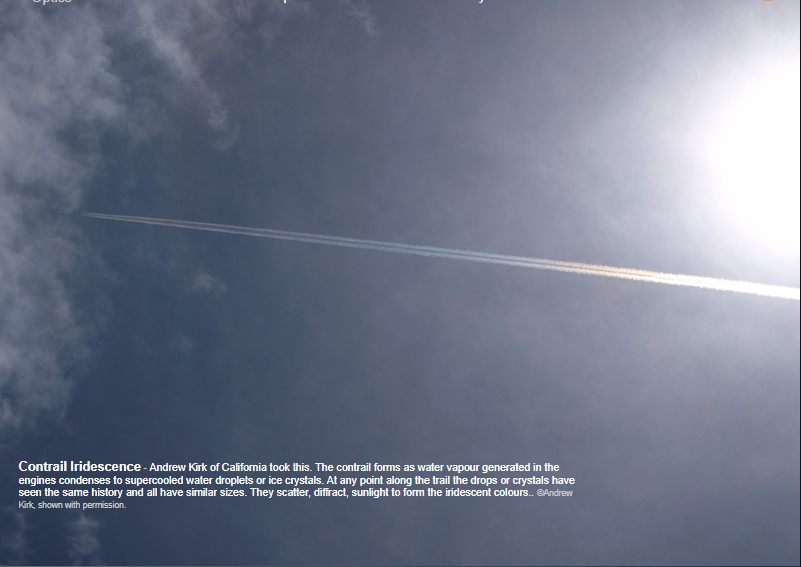Contrail Colours
Contrail Colors: Unveiling the Beauty in the Sky
Have you ever looked up at the sky and marveled at the vibrant colors trailing behind airplanes? Those colorful streaks are known as contrails, short for condensation trails. Contrails are formed when water vapor emitted from aircraft engines condenses into supercooled water droplets or ice crystals. While contrails are a common sight in the sky, the phenomenon of contrail colors, also known as contrail iridescence, adds an extra touch of magic to our atmospheric experiences.
Contrail iridescence occurs when sunlight interacts with the tiny water droplets or ice crystals present in contrails. These particles scatter and diffract sunlight, creating a stunning display of colors. The colors observed in contrails can vary from subtle pastels to vivid hues, depending on the size and shape of the particles involved.
The science behind contrail colors lies in the principles of light diffraction and scattering. When sunlight passes through the tiny water droplets or ice crystals in a contrail, it gets bent or scattered in different directions. This bending and scattering of light cause the different colors of the spectrum to separate and become visible to our eyes.
The colors seen in contrails are similar to those observed in other atmospheric optical phenomena, such as rainbows and halos. However, contrail colors have their unique characteristics. Unlike rainbows, which are caused by the refraction and reflection of sunlight within raindrops, contrail colors result from the scattering of sunlight by water droplets or ice crystals suspended in the air.
The size and shape of the water droplets or ice crystals within a contrail play a significant role in determining the colors observed. Smaller particles tend to produce more vivid and saturated colors, while larger particles may result in softer, pastel-like hues. The distribution of particle sizes along the contrail can also influence the overall color appearance, creating gradients or variations within the trail.
Contrail colors are most commonly observed when the sun is low on the horizon, such as during sunrise or sunset. This is because the sunlight has to pass through a larger portion of the Earth's atmosphere, increasing the likelihood of scattering and diffraction. Additionally, the angle at which sunlight interacts with the contrail can affect the intensity and appearance of the colors.
The phenomenon of contrail colors has fascinated sky gazers and photographers alike. Capturing the beauty of these ethereal displays has become a popular pursuit among aviation enthusiasts and nature photographers. The interplay between light, water particles, and the vast canvas of the sky creates endless opportunities for stunning visual compositions.
Contrail colors serve as a reminder of the intricate and dynamic nature of our atmosphere. They offer us a glimpse into the hidden wonders that surround us every day, reminding us to look up and appreciate the beauty above. So, next time you spot a contrail stretching across the sky, take a moment to observe the colors dancing within it, and let yourself be captivated by the artistry of nature's canvas.

Contrail Iridescence - Andrew Kirk of California took this. The contrail forms as water vapour generated in the engines condenses to supercooled water droplets or ice crystals. At any point along the trail the drops or crystals have seen the same history and all have similar sizes. They scatter, diffract, sunlight to form the iridescent colours.. ©Andrew Kirk, shown with permission.
Note: this article has been automatically converted from the old site and may not appear as intended. You can find the original article here.
Reference Atmospheric Optics
If you use any of the definitions, information, or data presented on Atmospheric Optics, please copy the link or reference below to properly credit us as the reference source. Thank you!
-
<a href="https://atoptics.co.uk/blog/contrail-colours/">Contrail Colours</a>
-
"Contrail Colours". Atmospheric Optics. Accessed on April 25, 2024. https://atoptics.co.uk/blog/contrail-colours/.
-
"Contrail Colours". Atmospheric Optics, https://atoptics.co.uk/blog/contrail-colours/. Accessed 25 April, 2024
-
Contrail Colours. Atmospheric Optics. Retrieved from https://atoptics.co.uk/blog/contrail-colours/.